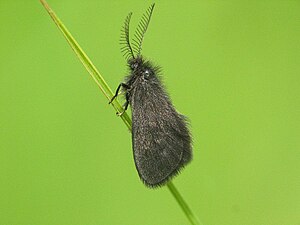Meadow sack carrier
| Meadow sack carrier | ||||||||||||
|---|---|---|---|---|---|---|---|---|---|---|---|---|

Meadow sack carrier ( Epichnopterix plumella ) |
||||||||||||
| Systematics | ||||||||||||
|
||||||||||||
| Scientific name | ||||||||||||
| Epichnopterix plumella | ||||||||||||
| ( Denis & Schiffermüller , 1775) |
The meadow sack carrier ( Epichnopterix plumella ) is a butterfly ( moth ) from the family of the sack carrier (Psychidae). The species is also known as the small wool sack carrier or soft grass sack carrier.
features
Construction of the Imago
The adult animal, the imago , shows a clear sexual dimorphism . The male has a wingspan of about ten to twelve millimeters, his body is black and shaggy and woolly. Both the front wings and the rear wings are rounded at the wing tip. The sensors are combed on both sides.
The female is red-yellow, her abdomen has a yellow spot. The wings are stubby.
Construction of the caterpillar
The basic color of the caterpillar is red, the caput (head) is black. On the red body there are black back plates, which are segmented by yellow stripes.
Like many sack carriers , the caterpillar weaves itself into a silk sack to which it attaches foreign materials. This sack has a round to oval cross-section, the foreign materials are long, flat blades of grass made of various grasses, they protrude above the silk sack and are arranged parallel to the longitudinal axis of the silk sack. The entire structure is shorter than 20 millimeters and is spun onto the food plants. The upward-facing front is open so that the caterpillar can stick out its front segments and front legs.
Synonyms
- Epichnopterix pulla Esper, 1785
Occurrence
The meadow sack carrier is common in large parts of central and western Europe including the British Isles . Its distribution area extends in the north to Schleswig-Holstein . There is a risk of confusion with related species in the Alpine region, the Mediterranean countries, Eastern Europe and the Balkan Peninsula . In Paraguay the way from Europe was introduced.
Way of life
Until the end of March, the caterpillar moves with its sack to new food plants such as red fescue ( Festuca rubra agg. ), Blue pipe grass ( Molina caerulea ), vetches ( Vicia spec. ) And Norway plantain ( Plantago lanceolata ). The female sacks are usually spun onto stones, bushes or trunks in sunny places at a height of 20 to 50 centimeters. The male sacks are attached to the vegetation near the ground. After pupation , the male imago begins to fly from April to July and is mainly found in meadows and debris areas. The preferred weather for flying is sunny days. The females rarely fly because of his stumps to the reformed wing. In suitable habitats , this small butterfly can be found very numerous.
literature
- Jozef Ponec: Butterflies of our homeland. Verlag Obzor, Bratislava, ISBN 3-8112-0380-0 (German translation of the original Slovak edition from 1982).
Web links
- Lepiforum eV: Taxonomy and photos of Epichnopterix plumella
- Sabine Jelinek: Nafoku - natural and photo-Kun t , image of the sachet of Epichnopterix plumella
- Natural history information system by Marion and Michael Kurz and Christof Zeller
- Markku Savela: Lepidoptera and some other life forms (English)
- Epichnopterix plumella at Fauna Europaea
Individual evidence
- ↑ a b c d e Jozef Ponec: Butterflies of our homeland. Verlag Obzor, Bratislava, ISBN 3-8112-0380-0 (German translation of the original Slovak edition from 1982).
- ↑ W. Sauter and P. Hättenschwiler: To the system of the palaearctic Psychidae. ( Memento of the original from December 15, 2013 in the Internet Archive ) Info: The archive link was inserted automatically and has not yet been checked. Please check the original and archive link according to the instructions and then remove this notice. (PDF; 208 kB) Part 3: Identification key for the bags. In: Nota lepid. 27, No. 1, pp. 59-69.
- ↑ Epichnopterix plumella (Denis & Schiffermüller 1775). Fauna Europaea, Version 1.3, April 19, 2007 , accessed on August 1, 2007 .
- ↑ a b Günter Ebert (Ed.): The butterflies of Baden-Württemberg. Volume 3: Moths I (root borer (Hepialidae), wood borer (Cossidae), ram (Zygaenidae), snail moth (Limacodidae), sack bearer (Psychidae), window spot (Thyrididae)). Ulmer Verlag Stuttgart 1993. ISBN 3-8001-3472-1 .